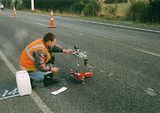You got my help.
I pavement engineer, with so much physical input from years of skid testing for public safety

I use a lot of Ford components in my engines which are Honda designed and made in the aftermath of Ford opting out of the Honda/Ford stratified charge four cylinder engines of the late 70's. Suddenly, Honda became the most amazing paid sub contractor to the world of economy, and its F1 work was even more helpfull.
Hondas "do more with less" philosophy has yielded a golden age of economy, and the rest of the economy ethos has come through from absolutely radical reverse engineering for the five parasitic losses of
1. frontal area,
2. aerodynamics,
3. rolling resistance due to tire type, width and load,
4. drive train loss
5. Vehicle weight and its impact on acceleration and efficency.
The management of the engine power by the nut behind the wheel brokers the enviromental and road load factors
6. environment (its pressure/air density, humidity and composition),
7. road load (due to
7a traffic density,
7b longitundinal/vertical grade interplay,
at varying phase lenghts and maganitues impact of
7c mega texuture [big aligments above 55 ft phase length],
7d macrotexture [55 ft to 1 ft horizontal aligments]
and
7e microtexture [the fine surface texture below 1 ft to the factor of friction measurent, differernt for gravel, sand, cement, asphalt, bitumen, tar seal macadams].
7f road strength makes an impact on road load too (basecourse and subgrade strength for flexiable and unyielding constructions).
This site majors on the human factor, and how you deal with the "Your Results May Vary" parts of the EPA/Euro fuel figures. And that's the even smarter than the very cutting edge way people here deal with making mpg by engineering changes.
I have been using a RoadWarriorDyno System basically as a partial low to high load drive-ablity test, which validates air fuel ratios, advance, knock under load, knock when using low grade gas.
The calculated road load table is based on the Coastal Otago and Milford Highway topo and gps plots I've collected over the years. (a sample of Coastal Otago below). Each crimson RS is a 10 mile 'mile marker', and the blue readings are where I've intensively surveyed the road over the past 10 years since the R~S data base was set up as a green engineering kadet waving his Garmin globalnav back in the early noughtees. Back then, I called it RS 2002i, and spent late nights linking everything by co-ordinate geometery.The yellow SN are special control sites for coastdown readings so I can determine overall road load.
I learned about the need to do this from the legandary Doug McMillan, who with the help of a road closure initated by a friendly official, drove a Honda VTEC CRX at 7 Mile Road, Oamaru, establishing 148.68 mph on 19 October 1997 with only 97 cubic inches, a class record. This was pivitol in me starting with a real world road load database. His figures in a magazine inspired me to do this. Him, and Burt Monroe..

See latest info at
http://www.hondata.com/hondata_speed...s_release.html, and
http://www.hondatuningmagazine.com/f...r/viewall.html
